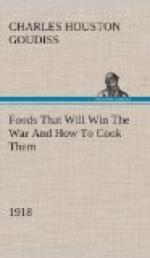Do not expect that the use of other cereals in bread-making will reduce the cost of your bread. That is not the object. Saving of wheat for war needs is the thing we are striving for, and this is as much an act of loyalty as buying Liberty Bonds. It is to meet the crucial world need of bread that we are learning to substitute, and not to spare the national purse.
Besides this saving of wheat, our Government also asks us to omit all fat from our yeast breads in order to conserve the diminishing fat supply. This may seem impossible to the woman who has never made bread without shortening, but recent experiments in bread-making laboratories have proved that bread, without shortening, is just as light and as good in texture as that made with shortening—the only difference being a slight change in flavor. These experiments have also shown that it is possible to supply shortening by the introduction of 3 per cent. to 5 per cent. of canned cocoanut or of peanut butter, and that sugar may also be omitted from bread-making recipes. In fact, the war is bringing about manifold interesting experiments which prove that edible and nutritious bread can be made of many things besides the usual white flour.
The recipes herewith appended, showing the use of combinations of cereals and wheat, have been carefully tested in The Forecast School of Modern Cookery. Good bread can be made from each recipe, and the new flavors obtained by the use of other grains make a pleasing and wholesome variety.
A family which has eaten oatmeal or entire wheat bread will never again be satisfied with a diet that includes only bread made from bleached flour. Children, especially, will be benefited by the change, as the breads made from coarser flours are not only more nutritious, but are rich in the minerals and vitamine elements that are so essential to the growth of strong teeth, bones and growing tissues.
The homemaker, too, will never regret her larger acquaintance with bread-making materials, as the greater variety of breads that she will find herself able to produce will be a source of pleasure and keen satisfaction.
[Illustration: Breads Made From the Coarser Flours, Whole Wheat, Cornmeal, Rye, Conserve Our Wheat Supply]
To Conform to U.S. Food Administration Regulations During the War, Eliminate Fat and Sweetening in Breads—Whenever Fat Is Used, Use Drippings
THE USE OF CORN
CORNMEAL ROLLS
1 cup bread flour 1 cup cornmeal 4 teaspoons baking powder 2 tablespoons fat 1 egg 1/3 cup milk 1-1/2 teaspoons salt 1 tablespoon sugar
Mix and sift dry ingredients and cut in the fat. Beat the egg and add to it the milk. Combine the liquid with the dry ingredients. Shape as Parker House rolls and bake in a hot oven 12 to 15 minutes.




